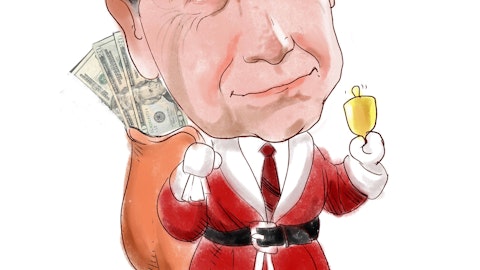Eric Zhang: Got it. Thank you.
Operator: Our next question comes from David Begleiter from Deutsche Bank. Your line is now open.
David Begleiter: Thank you. Celeste your Q2 guidance is a little bit below Street expectations. Is that due to hygiene or other factors?
John Corkrean: Hey David, I’ll chip in on this one. I guess when we look at it — we probably don’t look at it relative to consensus, but more so kind of to trends and year-on-year. So, midpoint, yes, would be a little bit lower growth rate than Q1. I think the biggest item there is we’re getting our biggest net pricing raws benefit in Q1. That will be a little bit lower in Q2 and actually a little — it will narrow as we go through the year. But offsetting that, we’re seeing synergies and restructuring benefits ramp up. So, I think it’s — the assumptions really that things — the backdrop for Q2 looks very similar to Q1, but we get a little bit less net pricing and raw benefit.
David Begleiter: Got it. And based on that Q2 guide, your second half guidance EBITDA is up 29% versus your first half EBITDA guidance and results. Can you help us bridge that increase of almost 30% from Q1 — from first half to second half EBITDA?
John Corkrean: Yes, I mean it’s mostly driven by seasonality and the fact that it is — the Q1 is such a low volume quarter. So, I think I mentioned the restructuring benefits and the synergies. So, those will step up too as we go through — as we go from first half to second half, but it’s largely a seasonality impact.
Celeste Mastin: Yes. And David when you look at the trends in the business, we have some favorable trends on our side, right? So, we’ve got our index prices flattening out. Our construction season is really ramping up, particularly in our roofing space, which drives a high EBITDA margin for us. I’m anticipating continued strength in China and I want to elaborate on that because that is in part the market in China, but also some really tremendous market share gains in China as well. So, I’ll come back to that. We’ve got destocking that’s complete in all of the GBUs. And as John just identified, we’ve got synergies and restructuring. But just to talk a little bit about some of these market share gains our electronics business was up 50% versus prior year Q1.
And we’re really seeing some excellent work come to fruition there. In fact 30% of our new volume in electronics is actually coming from new models. So, what that tells me is that our team is now fully integrated into these customers so much so that they become part of their development cycle. So, we’re winning a lot. We’re well entrenched in that space and it also indicates that our customers have gone back to innovating. So, they’re back on their product upgrade cycle post-pandemic. And that’s really important because that’s the opportunity that we’ve to get in and drive share take and to really bring solutions to the customer base. So, that’s just one example.
John Corkrean: And David I might just add something on the sequential impact because we don’t always look at the business the same way and I guess that’s an insight that I had looked at before. But I looked at last year and last year, our second half EBITDA was up a little over 30% versus the first half. So, I think that’s a pretty — it’s not unusual to see that type of trajectory.
David Begleiter: Right. Thank you very much. Thank you.
Celeste Mastin: Thanks David.
Operator: The next question comes from Rosemarie Morbelli from Gabelli Funds. Your line is now open.
Rosemarie Morbelli: Thank you very much. Good morning everyone. Celeste I was wondering — well two things. First of all, following up on your customers innovating and you’re gaining shares in the electronic arena, now electronic encompasses a lot of things. So, if you could give us a better feel for which areas you’re really doing well? And then my second — oh go ahead go ahead I’ll ask later.
Celeste Mastin: Okay. Thanks, Rosemarie. And absolutely, happy to elaborate on that. So, let me give you a few examples. So, one example would be in consumer electronics. We just replaced a competitor with a PFAS containing product, with our own PFAS-free two-part epoxy for trackpads. So we’re able to take advantage of this trend away from PFAS, and bring our own products that can perform without it. Another example would be in mobile phones. So, we just with one manufacturer, we just took a 100% share of the touchpad bonding and the touchpad edge gap bonding with a reactive hot-melt polyurethane for a phone that is going to be shipped to Africa, which is pretty exciting. This particular supplier is pursuing the African mobile phone market from China.
And then there’s even the category that I’ll call automotive electronics. So in Europe, we had last year won a vehicle display bonding application, with an OEM. That business has grown by 10 times over the course of the prior year. So, those are some electronics examples. Closely related to that, would be our success in aerospace. So one of the high points for our business in Europe this last quarter, was in aerospace. Example there would be, providing — us providing adhesives for interior trim in airplanes, and even more technical applications including — or now supplying a syntactic epoxy that brings great compressive strength, in bonding honeycomb kind of wall or door material, to carbon skins in the aircraft. So, those are all sorts of examples of products and markets that are in this growth category, as we’ve now defined it that we’re really competing successfully and winning.
Q – Rosemarie Morbelli: That is very helpful. I hope – you have something for the aerospace that will prevent doors….
Celeste Mastin: Me, too.
Q – Rosemarie Morbelli: And then my second question would be, on the hygiene side. You mentioned that it was smaller than in the past. So, are you walking away from a lot of businesses? Or has the industry changed to the degree, that it is not as interesting?




